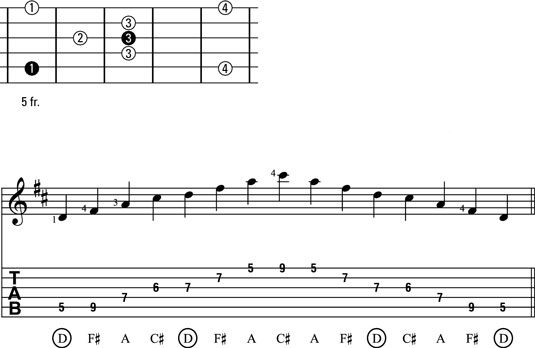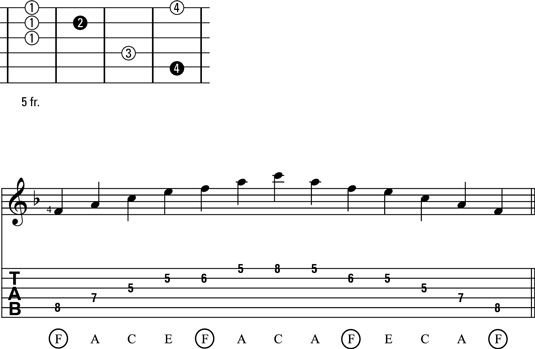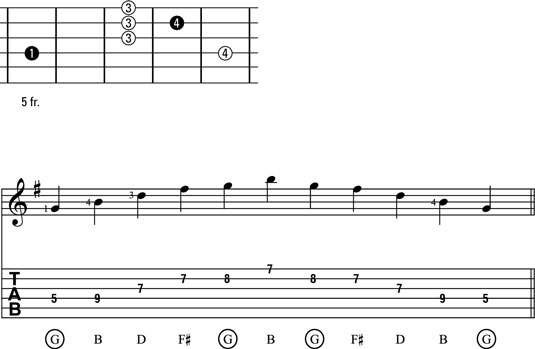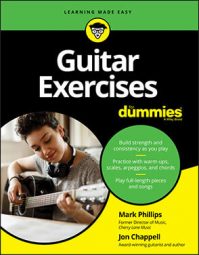You can derive a major seventh chord in many different ways. One way is to start with a major scale and play 1, 3, 5, 7. So in the key of C, a Cmaj7 (C major seven) chord is spelled C, E, G, B.
Major seventh chord arpeggio patterns #3, #4, and #5 span a bit less than two octaves. With a short pattern like #3, you may find yourself having to repeat notes to fill out an idea for a given arpeggio. Repeating notes is okay, but it means you have to think more creatively than when simply running a long pattern.
Major seventh arpeggio pattern #3
The following figure shows the neck diagram and corresponding music and tab for major seventh arpeggio pattern #3 in the key of D.This pattern can be tricky to master because it has two out-of-position stretches and a mini-barre option. But because the pattern is relatively short, you don’t need to isolate the passages. Instead, just run the pattern in its entirety until you can effectively execute the challenging aspects as smoothly as the straightforward ones.

Click here to download and print this arpeggio pattern.
Try the following exercise in the key of B. This pattern is placed in 2nd position — the second lowest possible on the neck — and it includes two stretches on widely separated strings, making it an ideal stretching exercise.

Major seventh arpeggio pattern #4
What follows is a neck diagram and corresponding music and tab for major seventh arpeggio pattern #4 in the key of F. This pattern invites only one alternate approach — a mini-barre with your 1st finger between the 3rd and 2nd strings.
Click here to download and print this arpeggio pattern.
Try your hand at the following exercise in the key of G. In 7th position, where this exercise is placed, everything becomes easier, including mini-barre substitutions. So try playing this exercise at a brisk clip.
What you may discover is that while the left hand poses no problems, playing four notes in a row each on a different string can be a challenge for the right hand — especially at fast tempos. Here are two solutions: The first is to simply slow down and work up speed gradually. And the second is, if you started out playing with a pick, go to fingerstyle, which makes consecutive-string playing a little easier than alternate picking.

Major seventh arpeggio pattern #5
On to major seventh arpeggio pattern #5, shown here in the key of G. In addition to an out-of-position note, you have the opportunity to employ several alternate fingering solutions. Here’s one to try: Instead of using the 3rd finger on the 3rd, 2nd, and 1st strings, bring up your 1st finger and plant it across the first three strings at the 7th fret immediately after you leave the first note of the exercise. Keep it there until the very last moment when you have to move it back to the starting note on the 4th string, 5th fret.
Click here to download and print this arpeggio pattern.
Now check out this exercise, which is in the key of F# in 4th position. This exercise is only one fret lower than the previous pattern. So what changes? You probably practiced the previous pattern with the notes in groups of two or four to the beat. Here, however, you have to think of grouping the notes in threes, because this exercise is in triplets. Remember to apply those accents on the first note of each group of three.


